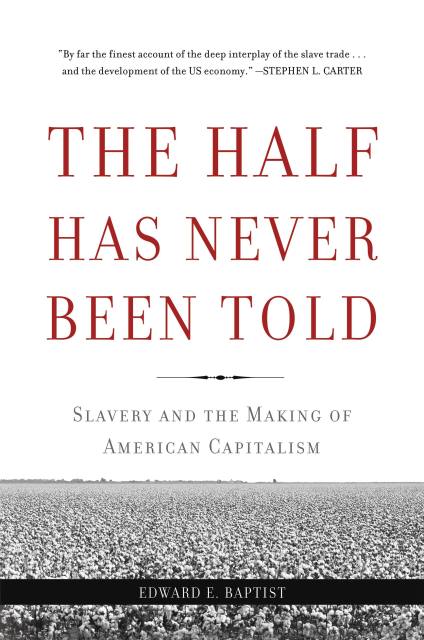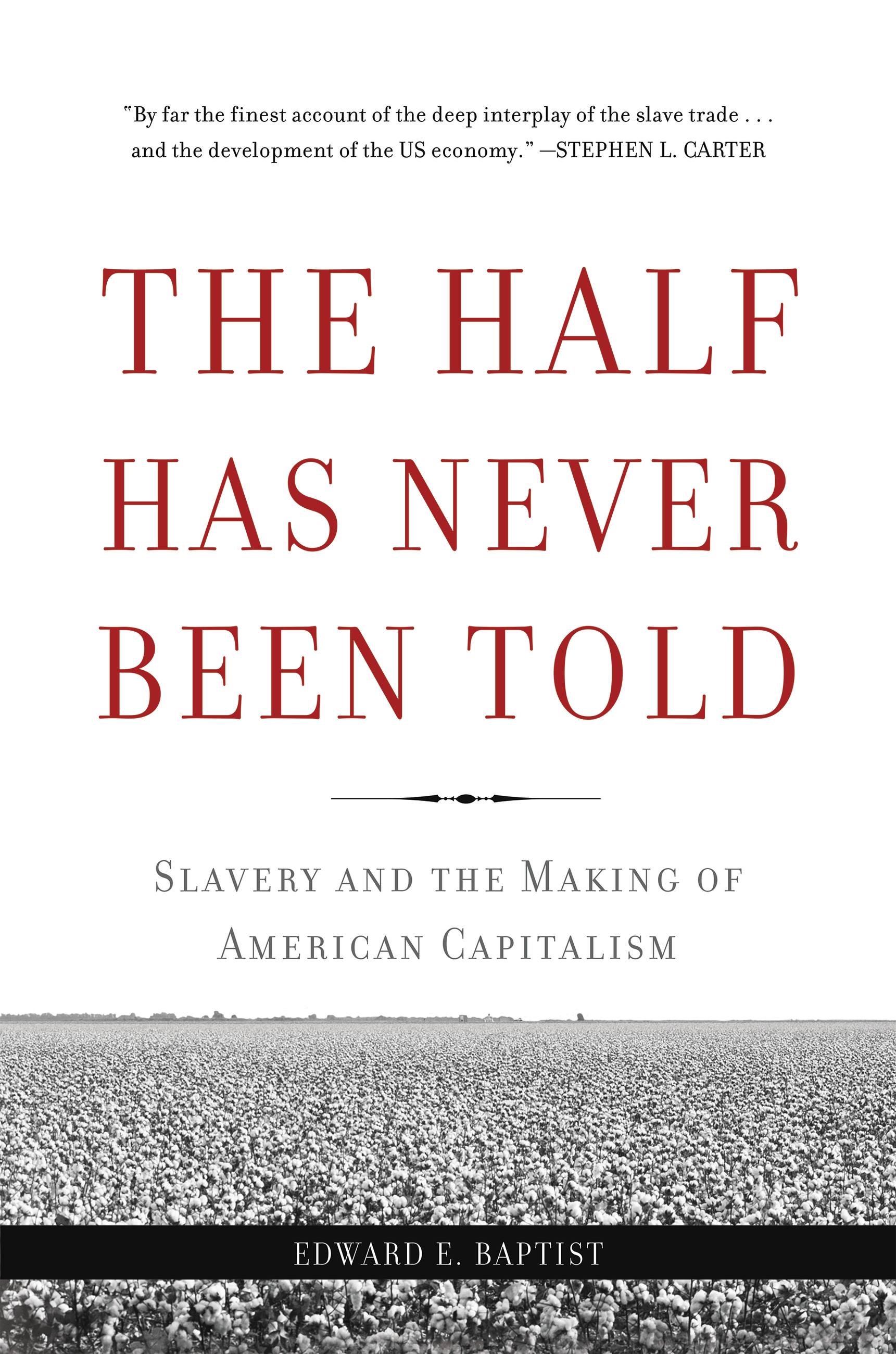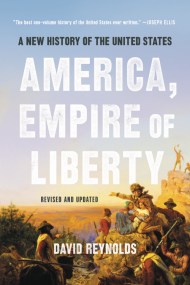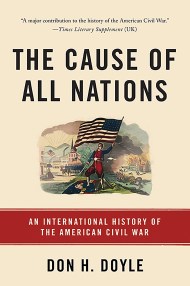Promotion
25% off sitewide. Make sure to order by 11:59am, 12/12 for holiday delivery! Code BEST25 automatically applied at checkout!
By clicking “Accept,” you agree to the use of cookies and similar technologies on your device as set forth in our Cookie Policy and our Privacy Policy. Please note that certain cookies are essential for this website to function properly and do not require user consent to be deployed.
The Half Has Never Been Told
Slavery and the Making of American Capitalism
Contributors
Formats and Prices
- On Sale
- Oct 25, 2016
- Page Count
- 560 pages
- Publisher
- Basic Books
- ISBN-13
- 9780465097685
Price
$15.99Price
$20.99 CADFormat
Format:
- ebook $15.99 $20.99 CAD
- Audiobook Download (Unabridged) $38.99
- Trade Paperback $24.99 $32.99 CAD
This item is a preorder. Your payment method will be charged immediately, and the product is expected to ship on or around October 25, 2016. This date is subject to change due to shipping delays beyond our control.
Buy from Other Retailers:
Winner of the Avery O. Craven Prize from the Organization of American Historians
Winner of the Sidney Hillman Prize
“A stinging indictment of slavery.” —NPR Books
Americans tend to cast slavery as a pre-modern institution—the nation's original sin, perhaps, but isolated in time and divorced from America's later success. But to do so robs the millions who suffered in bondage of their full legacy. As historian Edward E. Baptist reveals in The Half Has Never Been Told, the expansion of slavery in the first eight decades after American independence drove the evolution and modernization of the United States. In the span of a single lifetime, the South grew from a narrow coastal strip of worn-out tobacco plantations to a continental cotton empire, and the United States grew into a modern, industrial, and capitalist economy. Told through the intimate testimonies of survivors of slavery, plantation records, newspapers, as well as the words of politicians and entrepreneurs, The Half Has Never Been Told offers a radical new interpretation of American history.
-
“A stinging indictment of slavery.”NPR Books
-
“This book provides historical reference for the ways in which the enslavement of people for profit continues to impact and influence today’s institutions. A must‑read for everyone who has ever heard the statement, ‘But slavery is over! Why can’t they just get over it?’ or ‘Well, you know white people were slaves, too.’”The Atlantic
-
“Abolitionists were contemptuous of such self‑serving nonsense, but they too tended to see slavery as an economically inefficient, and morally reprehensible, hangover from the premodern past… In The Half Has Never Been Told, Edward E. Baptist takes passionate issue with such assumptions. He asserts that slavery was neither inherently inefficient nor a counterpoint to capitalism. Rather, he says, it was woven inextricably into the transnational fabric of early 19th‑century capitalism…Baptist writes with verve and a good eye for the dramatic.”Wall Street Journal
-
“Baptist has a knack for explaining complex financial matters in lucid prose.... The Half Has Never Been Told’s underlying argument is persuasive.”New York Times Book Review
-
“The overwhelming power of the stories that Baptist recounts, and the plantation‑level statistics he’s compiled, give his book the power of truth and revelation.”Los Angeles Times
-
“Wonderful.... Baptist provides meticulous, extensive, and comprehensive evidence that capitalism and the wealth it created was absolutely dependent on the forced labor of Africans and African‑Americans, downplaying culturalist arguments for Western prosperity.”Nation
-
“Baptist has a fleet, persuasive take on the materialist underpinnings of the ‘peculiar institution.’”Colson Whitehead, Mashable
-
“Digging into the large repository of oral histories from former slaves documented during the Great Depression, the book offers a moving account of suffering and resilience.”NPR's Code Switch
-
“Quite a gripping read. Baptist weaves deftly between analysis of economic data and narrative prose to paint a picture of American slavery that is pretty different from what you may have learned in high school Social Studies class.”Huffington Post
-
“A book unusual, even courageous, for its enormous ambition and admirable breadth…Baptist’s book is among the best single‑volume studies of the relationship between the expansion of slavery and the political economy of the United States…The Half Has Never Been Told has offered the historical backdrop for the stirring declaration ‘black lives matter.’”Times Literary Supplement
-
“You cannot understand the economy of the U.S. —or even of the world—without an understanding of how its development was driven by 19th century slavery. This book gives you that, in a stunningly readable, heartbreaking form. Genius.”Mark Bittman, Omnivoracious
-
“Baptist’s real achievement is to ground these financial abstractions in the lives of ordinary people. In vivid passages, he describes the sights, smells and suffering of slavery. He writes about individual families torn apart by global markets. Above all, Baptist sets out to show how America’s rise to power is inextricable from the suffering of black slaves.”Salon
-
“Thoughtful, unsettling.... Baptist turns the long‑accepted argument that slavery was economically inefficient on its head, and argues that it was an integral part of America’s economic rise.”Daily Beast
-
“Edward E. Baptist’s The Half Has Never Been Told: Slavery and the Making of American Capitalism is an achievement of the first order…With Baptist’s meticulous research and comprehensive, chronological approach, the other half of the story has now been told, and told very well. The reader is readily engaged in this scholarly treatment of over 400 pages, thanks to Baptist’s narrative style and his skillful interweaving of personal stories from slave and enslaver memoirs and letters with complex political and economic context.”Washington Independent Review of Books
-
“Baptist has written an important book that is also indicative of a current trend in historiography that takes a highly critical view of the development of modern capitalism. It is refreshing.”The Historian
-
“A prodigious work that stacks up a mountain of documentary evidence.”American Interest
-
“In addition to smashing paradigms about antebellum slavery, the book features evocative explorations of how African Americans developed a common culture despite the individual and family devastation inflicted by ‘enslavers.”Choice
-
“Baptist makes us see an unpalatable truth: that slavery was a tough central strand of American history and that it was not antithetical to capitalism but rather symbiotic with it. Baptist’s fine book deserves to stand alongside Sven Beckert’s prize‑winning Empire of Cotton: A Global History; both books indispensably illuminate slavery’s economic significance and its global reach.”Virginia Magazine
-
“A vital and enthralling book.”Socialist Worker
-
“A stunning indictment of African‑American slavery, contextualizing the history of the “peculiar institution” within emerging 19th‑century American capitalism…Baptist’s great contribution is in providing general readers with insights into slavery’s horrors and how it transformed the South into the dominant force in the global market and cotton into the most important raw material in the world economy.”News & Observer
-
“Baptist’s exhaustively researched, elegantly written and provocatively argued book details the connection between the growth of the institution of human bondage and economic innovations from 1783‑1861.”Providence Journal
-
“An ambitious and thorough account of how American capitalism was not an innate gift, but rather a system of gradual development, aiming to penetrate all aspects of the American public …Thanks to its comprehensive, chronological approach and its lucid prose, the book is a rich addition to the literature on the economics of slavery and American development. The Half Has Never Been Told is required reading.”H-Law
-
“Baptist’s book fluidly interweaves economic analysis of the slave trade and the production that came from it—principally cotton—with heartbreaking stories of the lives and suffering of the people who were enslaved… The book enlightens the mind and pierces the heart. It should summon our collective will to finally redress the lingering injustices created by this most American institution.”Labor Notes
-
“Edward E. Baptist’s brilliant book, The Half Has Never Been Told, soars because of the author’s decision to root his analysis in the human dimension. The book transcends anything that has previously been written about slavery...In short, Baptist has humanized the lives of American slaves, liberated them from one of the most inhumane systems mankind ever devised. The entire country needs to do the same.”CounterPunch
-
“The Half Has Never Been Told amounts to a powerful counternarrative of early American ‘progress.’ It should be valuable, both in and out of classrooms, as a template for remapping readers’ understanding of the young country’s economic development.”The Junto
-
“Baptist’s prose is simultaneously evocative, gripping… [The Half Has Never Been Told] is likely to find its place among rare works of scholarship on slavery that successfully reaches a mass audience and reshapes how a generation of readers thinks about one of America’s most defining institutions.”Journal of North Carolina Association of Historians
-
“A piece of scholarship that will both redefine the study of the ‘peculiar institution’ and shed fresh light on the relationship between slavery and modernity… The Half Has Never Been Told will undoubtedly shape debates in the field for many years to come.”Register of the Kentucky Historical Society
-
“[Baptist] presents a detailed case, showing how the American economy benefitted from profits gained by forced labor and financial instruments that enabled investors to profit from slavery.”Seattle Times
-
“Edward Baptist has written one of the richest and most provocative accounts of American slavery I have ever read. He so powerfully captures the pain and tragedy of plantation slavery.”Christian Century
-
“A myth‑busting work that pursues how the world profited from American slavery…this is a complicated story involving staggering scholarship that adds greatly to our understanding of the history of the United States.”Kirkus (starred)
-
“Baptist has written a book that truly deepens and broadens our understanding of slavery… Professional historians and lay readers will pore over this book for years to come. Essential for all readers interested in American history and the history of slavery.”Library Journal (starred)
-
“Baptist renders history and economics with the power of prose that seeks to tell a fuller story than has been told of American slavery…An insightful look at U.S. slavery and its controversial role in the much‑celebrated story of American capitalism.”Booklist (starred)
-
“An unapologetic, damning, and grisly account of slavery’s foundational place in the emergence of America as a global superpower, balancing the macro lens of statistics and national trends with intimate slave narratives. Delivered in a voice that fluidly incorporates both academic objectivity and coarse language… Baptist’s chronicle exposes the taint of blood in virtually all of the wealth that Americans have inherited from their forebears, making it a rewarding read for anyone interested in U.S.A.’s dark history.”Publishers Weekly
-
“A compelling case for recognising slavery as fundamental to the rise of the United States.”Guardian Australia
-
“While on one level this is a work of persuasive and painstaking economic analysis, The Half Has Never Been Told never loses sight of the people whose commodification ‘shaped every crucial aspect of the economy and politics of the new nation.’”Race and Class (UK)
-
“It taught me so much about slavery and how slavery enabled America to become America. Every time I left my house after reading, I saw the world differently. I saw the legacy of human misery underpinning it all.”Jesmyn Ward, author of Sing, Unburied, Sing
-
“The Half Has Never Been Told is a true marvel. Groundbreaking, thoroughly researched, expansive, and provocative it will force scholars of slavery and its aftermath to reconsider long held assumptions about the ‘peculiar institution’s’ relationship to American capitalism and contemporary issues of race and democracy. Engagingly written and bursting with fresh, powerful, and provocative insights, this book deserves to be widely read, discussed, and debated.”Peniel Joseph, author of The Sword and the Shield
-
“This book, quite simply, offers the fullest and most powerful account we have of the evolution of slavery in the United States from the Revolution to the Civil War. Edward Baptist’s account is eloquent, humane, passionate, and necessary.”Edward L. Ayers, Bancroft Prize-winning author of In the Presence of Mine Enemies
-
“By far the finest account of the deep interplay of the slave trade...and the development of the U.S. economy.”Stephen L. Carter, Yale Law School, author of The Emperor of Ocean Park
-
“This book reveals a dirty secret about American business and how commerce first boomed before the Civil War. Baptist unearths a big, nasty story: in the North and the South, slavery was the tainted fuel that kindled the fires of U.S. capitalism and made the country grow.”Edward Ball, author of Slaves in the Family
-
“Edward Baptist’s book belongs on the very short shelf of field‑defining histories of slavery. It will be read and debated for a long time to come.”Thomas J. Sugrue, author of Sweet Land of Liberty
Newsletter Signup
By clicking ‘Sign Up,’ I acknowledge that I have read and agree to Hachette Book Group’s Privacy Policy and Terms of Use







